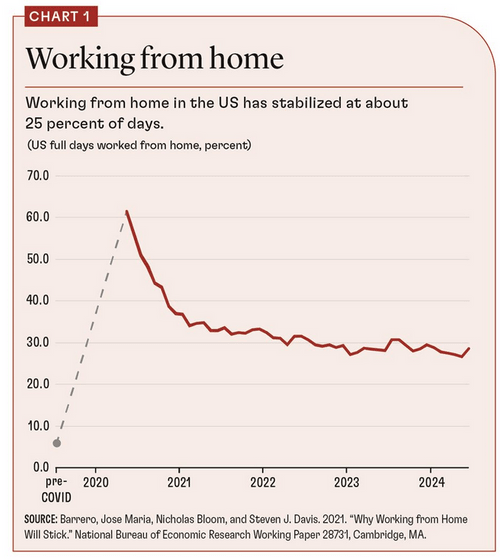Remote work improves productivity, with the number of remote workers increasing five times since the COVID-19 pandemic compared to before the pandemic

Since the COVID-19 pandemic of 2020, remote work has become widespread in various companies. As the pandemic subsides, there is a
Working From Home Is Powering Productivity
https://www.imf.org/en/Publications/fandd/issues/2024/09/working-from-home-is-powering-productivity-bloom

In a survey of about 30,000 people, the number of people who switched to remote work has increased sharply since the COVID-19 pandemic, and in 2020, when the pandemic occurred, the proportion of people working remotely exceeded 60%, about 10 times that of people who worked remotely before the pandemic. Even after 2021, when the pandemic is on the way to a close, it has been
The graph below shows the percentage of people who started working remotely before and after the pandemic. It shows that the number of remote workers who surged in 2020 when the pandemic occurred is continuing to work remotely in 2021 and beyond.

It has also been
Furthermore, it has been suggested that hybrid work may increase birth rates because it allows for the sharing of housework and child-rearing responsibilities. Previous studies have shown that couples who work remotely one day or more a week want to have 0.3 to 0.5 more children per household.
In addition, as remote work becomes more widespread, companies will need less office space. This will allow them to rent out surplus office space to residential and retail businesses, allowing them to use the space for other purposes. It has also been revealed that the spread of remote work has reduced traffic in cities. (PDF file) A January 2024 study found that car speeds increased by 2 to 3 miles per hour (about 3.2 to 4.8 km) during morning rush hour compared to before the pandemic, and the IMF said, 'This will save the average office worker a few minutes a day.'

In the longer term, allowing employees to work partially or fully remotely could free up underutilized land for housing,
Previous research has shown that hybrid work does not reduce employee productivity. In addition, the spread of remote work makes it easier for companies to find employees who fit their positions in countries and regions where they previously could not. The IMF says, 'Remote work enables global matching of employees and companies, improving labor productivity.'
In addition, the spread of remote work has led to the creation of many new technologies to accommodate the new way of working, which is working from home. Among new patent applications filed at the U.S. Patent and Trademark Office (PDF file) , the proportion of products related to 'remote work' and 'telecommuting' has been rapidly increasing since 2020.

'The widespread use of remote working has led to better webcams and monitors, augmented reality, virtual reality, holograms and other technologies, which will make hybrid and remote work even more productive in the future. This could create a positive feedback loop between increased productivity and remote working,' the IMF said.
'The widespread use of remote work since the COVID-19 pandemic has largely offset the slowdown in productivity before the pandemic,' said Nicholas Bloom, a professor at Stanford University. 'I have never seen such widespread beneficial change in my career as an economist.'
Related Posts:
in Science, Posted by log1r_ut







